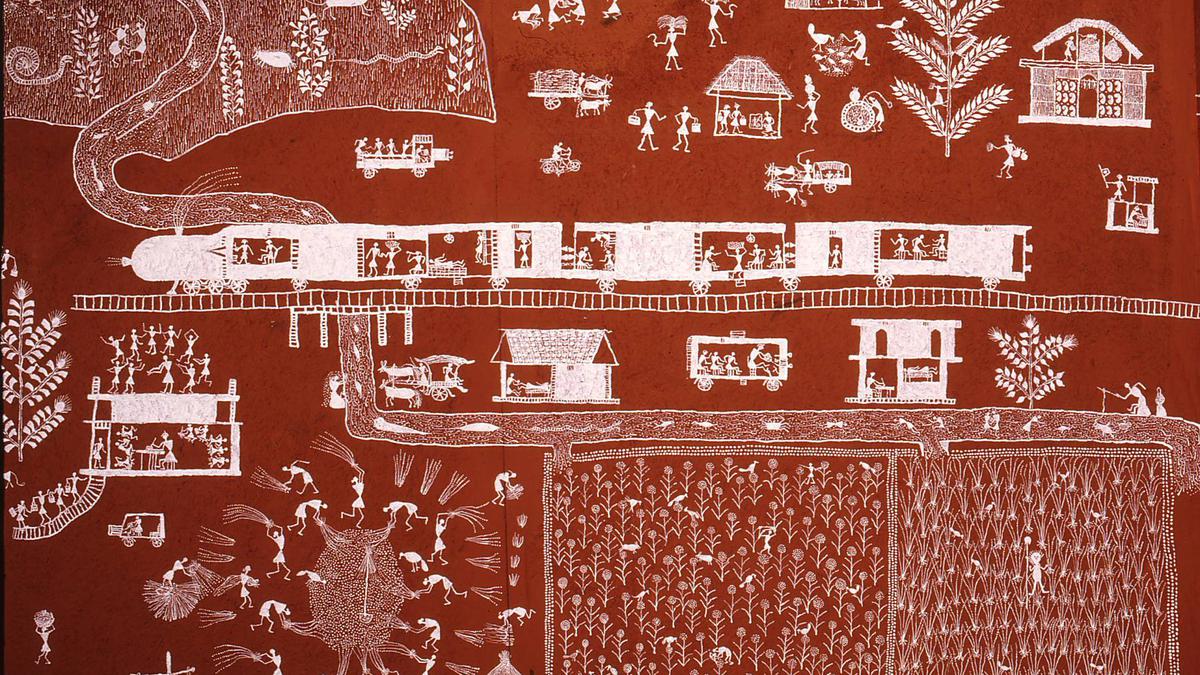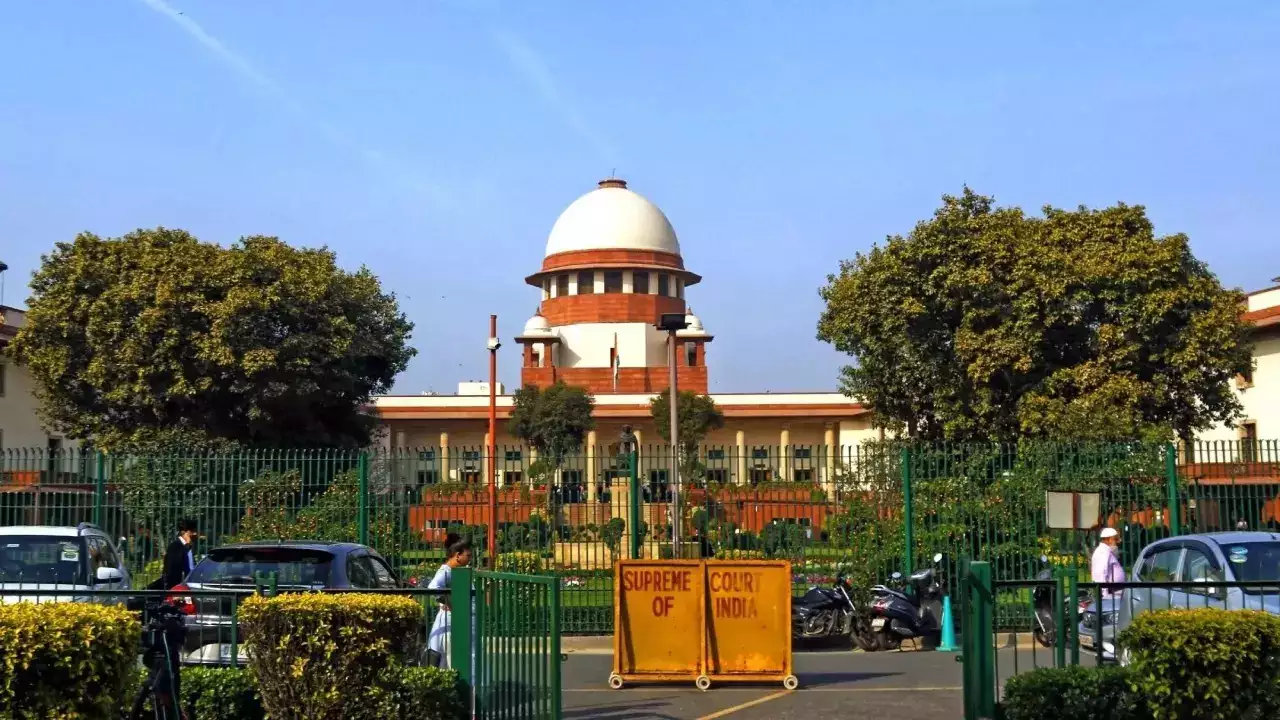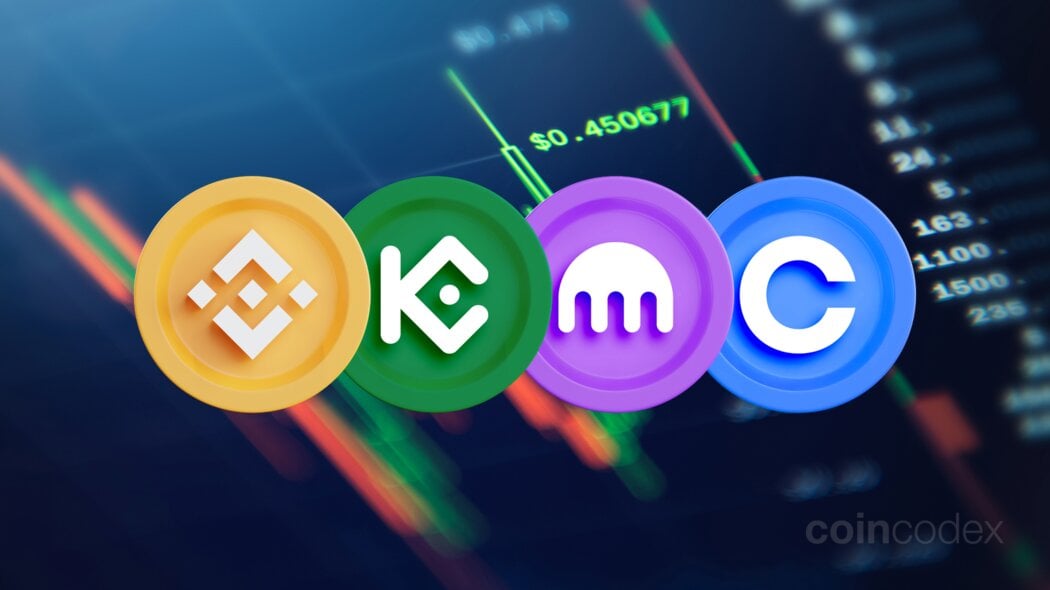Life through geometry in Warli (The Hindu)

- 29 Dec 2023
Why is it in the News?
Warli Whisperers, an exhibition by the Inherited Arts Forum, traces the artistic journey of the celebrated Mashe family from Maharashtra.
About the Warli Art:
- Origin: Warli art is a tribal form originating from the North Sahyadri region of Maharashtra, with roots dating back to the 10th century AD.
- However, it gained recognition for its unique style in the early 1970s.
- Practitioners: Traditionally, Warli art was practiced by Suvasinis, the women of the Warli tribe, who adorned the Lagn Chowk or wedding square with their artistic expressions.
- Characteristics: Warli artists draw inspiration from nature, depicting scenes of farming, food gathering, village life, and elements from the natural world.
- These paintings are mainly dominated by basic geometric shapes like circles, triangles and squares.
- These geometric shapes stand as a symbol of natural elements in our environment.
- For example, the circles represent the sun and moon, the triangles represent the mountains and the squares are considered as the central motifs of the painting.
- Techniques and Materials: The paintings showcase triangles, circles, and lines in stark white against a mud brown background, narrating stories of village life, customs, and traditions.
- Modified bamboo sticks serve as paintbrushes, and the colours are derived from nature, such as brown and orange from henna, indigo from dye, red from bricks, and white from thick rice paste.
- Warli art serves as a vibrant portrayal of the everyday and social occurrences within the Warli tribe of Maharashtra, serving as a means to adorn the walls of village houses.
- Concerns: It was not recognised as an art form even though it was in practice for centuries.
Warli Tribe
- The Warli tribe, categorized as indigenous Adivasis, inhabit both the mountainous and coastal regions near the Maharashtra-Gujarat border.
- Their communication is conducted through an unwritten Varli language, classified within the southern zone of Indo-Aryan languages.
SC Collegium recommends names for Chief Justices of five High Courts (The Hindu)

- 29 Dec 2023
Why is it in the News?
The Supreme Court Collegium headed by Chief Justice of India D.Y. Chandrachud has recommended the appointment of Chief Justices to five High Courts.
What is the Collegium System?
- It is a system under which appointments and transfers of judges are done in the Supreme Court and High Courts.
- It is not rooted in the Constitution, iInstead, it has evolved through judgments of the Supreme Court.
- The Supreme Court Collegium, headed by the Chief Justice of India, consists of the court's four other most senior judges.
- Similarly, the High Court Collegium is chaired by its Chief Justice, along with the four other most senior judges of that specific high court.
Appointment of Judges: Constitutional Framework
- Constitutional Provision: Under Article 217, the President holds the authority to appoint judges of a high court.
- The appointment of the Chief Justice involves consultation with the Chief Justice of India and the respective state's governor.
- Similarly, consultation with the Chief Justice of the concerned high court is essential for appointing other judges.
- In cases where a high court serves multiple states, the President consults with the governors of all relevant states.
- No Minimum Age Requirement: The Constitution does not specify a minimum age for the appointment of high court judges.
- Qualifications of Judges: To qualify for a high court judge, an individual must:
- Be a citizen of India.
- Have held a judicial office within India's territory for ten years; or
- Have been an advocate of a high court (or successive high courts) for ten years.
Supreme Court Judgements:
- Second Judges Case (1993): The Supreme Court decreed that the appointment of a high court judge must align with the Chief Justice of India's opinion.
- Third Judges Case (1998): The Supreme Court emphasized that for the appointment of high court judges, the Chief Justice of India should consult a collegium comprising the two most senior judges of the Supreme Court.
- The consultation process involves more than the Chief Justice of India's individual opinion.
Is Pegasus spyware targeting journalists in India? (The Hindu)

- 29 Dec 2023
Why is it in the News?
Amnesty International and Washington Post recently announced that it has found the presence of Pegasus spyware, sold only to governments, on two Indian journalists’ phones.
What is Pegasus Spyware, and How Does it Infiltrate Devices?
- Pegasus is a sophisticated form of malware, covertly designed to gather information without the user's knowledge.
- Developer: Developed by the Israeli security firm NSO Group.
- Objectives: Pegasus serves three primary purposes:
- Collecting historical data on a device discreetly.
- Continuously monitoring user activities and gathering personal information.
- Transmitting the collected data to third parties.
Infiltration Mechanisms:
- Pegasus utilizes "zero-click exploits," exploiting vulnerabilities in popular apps like iMessage and WhatsApp.
- Notably, zero-click exploits require no user interaction, differentiating them from typical cyberattacks.
- Network injection attacks are another method employed by Pegasus, where unsecured websites are used to infiltrate devices within milliseconds of the user's visit.
What is a Zero-click exploit?
- A zero-click exploit involves the installation of malicious software on a device without the device owner's consent.
- Notably, it does not require any action from the device owner to initiate or complete the installation.
Specific Exploit in the Recent Case with Indian Journalists:
- The particular exploit reportedly used in the incidents is known as BLASTPAST (previously identified as BLASTPASS), unfolding in two phases.
- Initial Phase: The attack aims to establish a connection with Apple HomeKit, a platform enabling users to control various smart devices on their network.
- The primary objective of this phase might be to assess how the device could be vulnerable to exploitation or to maintain visibility for potential future attacks.
- Second Phase: Malicious content is sent through the iMessage app to the target device.
- This stage is pivotal as it delivers the complete spyware payload, enabling extensive surveillance and data collection.
Mines Ministry unveils draft rules for offshore minerals auction (The Hindu Business Line)

- 29 Dec 2023
Why is it in the News?
India’s Mines Ministry has proposed a new set of rules for the auction of offshore mineral blocks. It is also in the process of identifying such mineral blocks, including those in exclusive economic zones beyond territorial waters.
Context:
- To implement the amended Offshore Areas Mineral (Development & Regulation) Act, 2002 (OAMDR Act), the ministry has unveiled two draft rules:
- Offshore Areas Mineral Auction Rules: These rules delineate provisions governing the auctioning of production leases.
- Offshore Areas Existence of Mineral Resources Rules: These rules set forth norms for the exploration of minerals and deposits in offshore areas.
Offshore Areas Mineral (Development & Regulation) Act, 2002 (OAMDR Act):
- The OAMDR Act governs the development and regulation of mineral resources in India's territorial waters, continental shelf, exclusive economic zones, and other maritime zones.
About Offshore Areas Minerals (Development and Regulation) Amendment Bill, 2023:
- The Bill proposes amendments to the Offshore Areas Mineral (Development and Regulation) Act, 2002, governing mining activities in India's maritime zones.
Key highlights include:
- Empowering the government to reserve offshore areas without operating rights.
- Granting the administering authority the discretion to issue composite licenses or production leases to the government or a government company.
- Eliminating the provision for renewing production leases and setting a fixed fifty-year period, aligning with the Mines and Minerals (Development and Regulation) Act, 1957.
- Mandating the grant of production leases to the private sector through competitive bidding.
- Allowing non-competitive bidding for operating rights in mineral-bearing areas reserved by the central government for government entities or corporations.
- Restricting the grant of exploration licenses or production leases for atomic minerals to government or government corporations.
- Introducing a four-year timeline for the commencement of production and dispatch after executing a composite license or production lease, with a two-year timeline (extendable by one year) for re-commencement after discontinuation.
- Authorizing the central government to establish rules for mineral conservation, systematic development, and environmental protection in offshore areas, preventing or controlling pollution from exploration or production operations.
India's Maritime Zone Mineral Resources:
- India's maritime zone hosts diverse mineral resources, including lime mud off the Gujarat and Maharashtra coasts within the Exclusive Economic Zone (EEZ).
- Additionally, the region boasts construction-grade sand along the Kerala coast and heavy mineral placers in the inner-shelf and mid-shelf regions off Odisha, Andhra Pradesh, Kerala, Tamil Nadu, and Maharashtra.
- Phosphorite is found in the Eastern and Western continental margins, while the Andaman Sea and Lakshadweep Sea house Polymetallic Ferromanganese (Fe-Mn) nodules and crusts.
Govt issues PMLA notice to Binance, 8 other offshore crypto firms, asks IT Min to block URLs (Indian Express)

- 29 Dec 2023
Why is it in the News?
India's Financial Intelligence Unit has issued show cause notices to nine offshore crypto-currency operators, including Binance, for not complying with the anti-money laundering PML Act.
About the Financial Intelligence Unit India:
- Financial Intelligence Unit – India (FIU-IND) was set by the Government of India in November 2004 as the central national agency responsible for receiving, processing, analyzing and disseminating information relating to suspect financial transactions.
- FIU-IND is also responsible for coordinating and strengthening efforts of national and international intelligence, investigation and enforcement agencies in pursuing the global efforts against money laundering and financing of terrorism.
- It is an independent body reporting directly to the Economic Intelligence Council (EIC) headed by the Finance Minister.
Key Functions of FIU-IND:
- Information Collection: Act as the central hub for receiving various reports, including Cash Transaction Reports (CTRs), Non-Profit Organisation Transaction Reports (NTRs), Cross Border Wire Transfer Reports (CBWTRs), Reports on the Purchase or Sale of Immovable Property (IPRs), and Suspicious Transaction Reports (STRs) from diverse reporting entities.
- Information Analysis: Analyze the received information to unveil transaction patterns indicative of potential money laundering and associated criminal activities.
- Information Sharing: Collaborate by sharing intelligence with national intelligence/law enforcement agencies, national regulatory authorities, and foreign Financial Intelligence Units, fostering a collective effort against financial crimes.
- Central Repository: Establish and maintain a national database by consolidating reports received from reporting entities.
- Coordination: Strengthen the collection and sharing of financial intelligence through efficient national, regional, and global networks to combat money laundering and related crimes.
- Research and Analysis: Conduct ongoing monitoring and identification of strategic areas related to money laundering trends, typologies, and developments.
What are Virtual Digital Assets?
- As per the Income Tax Act, a 'virtual digital asset' is described as any information, code, number, or token (excluding Indian currency or foreign currency) generated through cryptographic means and blockchain technologies.
- These assets can be electronically transferred, stored, or traded.
- The definition explicitly covers non-fungible tokens (NFTs) or tokens of a similar nature, regardless of nomenclature.
